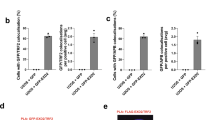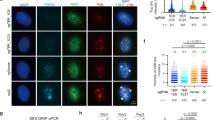Abstract
The tumor suppressor protein BRCA2 is a key component of the homologous recombination pathway of DNA repair, acting as the loader of RAD51 recombinase at sites of double-strand breaks. Here we show that BRCA2 associates with telomeres during the S and G2 phases of the cell cycle and facilitates the loading of RAD51 onto telomeres. Conditional deletion of Brca2 and inhibition of Rad51 in mouse embryonic fibroblasts (MEFs), but not inactivation of Brca1, led to shortening of telomeres and accumulation of fragmented telomeric signals—a hallmark of telomere fragility that is associated with replication defects. These findings suggest that BRCA2-mediated homologous recombination reactions contribute to the maintenance of telomere length by facilitating telomere replication and imply that BRCA2 has an essential role in maintaining telomere integrity during unchallenged cell proliferation. Mouse mammary tumors that lacked Brca2 accumulated telomere dysfunction–induced foci. Human breast tumors in which BRCA2 was mutated had shorter telomeres than those in which BRCA1 was mutated, suggesting that the genomic instability in BRCA2-deficient tumors was due in part to telomere dysfunction.
This is a preview of subscription content, access via your institution
Access options
Subscribe to this journal
Receive 12 print issues and online access
$189.00 per year
only $15.75 per issue
Buy this article
- Purchase on Springer Link
- Instant access to full article PDF
Prices may be subject to local taxes which are calculated during checkout







Similar content being viewed by others
References
Narod, S.A. & Foulkes, W.D. BRCA1 and BRCA2: 1994 and beyond. Nat. Rev. Cancer 4, 665–676 (2004).
Evers, B. & Jonkers, J. Mouse models of BRCA1 and BRCA2 deficiency: past lessons, current understanding and future prospects. Oncogene 25, 5885–5897 (2006).
Thorslund, T. & West, S.C. BRCA2: a universal recombinase regulator. Oncogene 26, 7720–7730 (2007).
Venkitaraman, A.R. Linking the cellular functions of BRCA genes to cancer pathogenesis and treatment. Annu. Rev. Pathol. 4, 461–487 (2009).
Nagaraju, G. & Scully, R. Minding the gap: the underground functions of BRCA1 and BRCA2 at stalled replication forks. DNA Repair (Amst.) 6, 1018–1031 (2007).
Tsang, E. & Carr, A.M. Replication fork arrest, recombination and the maintenance of ribosomal DNA stability. DNA Repair (Amst.) 7, 1613–1623 (2008).
Henson, J.D., Neumann, A.A., Yeager, T.R. & Reddel, R.R. Alternative lengthening of telomeres in mammalian cells. Oncogene 21, 598–610 (2002).
Cesare, A.J. & Reddel, R.R. Telomere uncapping and alternative lengthening of telomere. Mech. Ageing Dev. 129, 99–108 (2008).
Verdun, R.E. & Karlseder, J. The DNA damage machinery and homologous recombination pathway act consecutively to protect human telomeres. Cell 127, 709–720 (2006).
West, S.C. Molecular views of recombination proteins and their control. Nat. Rev. Mol. Cell Biol. 4, 1–11 (2003).
Thacker, J. & Zdzienicka, M.Z. The mammalian XRCC genes: their roles in DNA repair and genetic stability. DNA Repair (Amst.) 2, 655–672 (2003).
Badie, S. et al. RAD51C facilitates checkpoint signalling by promoting CHK2 phosphorylation. J. Cell Biol. 185, 587–600 (2009).
Palm, W. & de Lange, T. How shelterin protects mammalian telomeres. Annu. Rev. Genet. 42, 16.1–16.34 (2008).
Tarsounas, M. et al. Telomere maintenance requires the RAD51D recombination/repair protein. Cell 117, 337–347 (2004).
Jaco, I. et al. Role of mammalian Rad54 in telomere length maintenance. Mol. Cell. Biol. 23, 5572–5580 (2003).
Tarsounas, M. & West, S.C. Recombination at mammalian telomeres: an alternative mechanism for telomere protection and elongation. Cell Cycle 4, 672–674 (2005).
Maser, R.S. & DePinho, R.A. Telomeres and the DNA damage response: why the fox is guarding the henhouse. DNA Repair (Amst.) 8–9, 979–988 (2004).
Maser, R.S. & DePinho, R.A. Connecting chromosomes, crisis, and cancer. Science 297, 565–569 (2002).
Jacobs, J.J.L. et al. Senescence bypass screen identifies TBX2, which represses Cdkn2a(p19ARF) and is amplified in a subset of human breast cancers. Nat. Genet. 26, 291–299 (2000).
Silver, D.P. & Livingston, D.M. Self-excising retroviral vectors encoding the Cre recombinase overcome Cre-mediated cellular toxicity. Mol. Cell 8, 233–243 (2001).
Jonkers, J. et al. Synergistic tumor suppressor activity of BRCA2 and p53 in a conditional mouse model for breast cancer. Nat. Genet. 29, 418–425 (2001).
Herrera, E. et al. Disease states associated to telomere deficiency appear earlier in mice with short telomeres. EMBO J. 18, 2950–2960 (1999).
Blasco, M.A. et al. Telomere shortening and tumor formation by mouse cells lacking telomerase RNA. Cell 91, 25–34 (1997).
Muñoz, P., Blanco, R., Flores, J.M. & Blasco, M.A. XPF nuclease-dependent telomere loss and increased DNA damage in mice overexpressing TRF2 result in premature aging and cancer. Nat. Genet. 37, 1063–1071 (2005).
Blanco, R., Munoz, P., Flores, J.M., Klatt, P. & Blasco, M.A. Telomerase abrogation dramatically accelerates TRF2-induced epithelial carcinogenesis. Genes Dev. 21, 206–220 (2007).
Okamoto, K., Iwano, T., Tachibana, M. & Shinkai, Y. Distinct roles of TRF1 in the regulation of telomere structure and lengthening. J. Biol. Chem. 283, 23981–23988 (2008).
Sfeir, A. et al. Mammalian telomeres resemble fragile sites and require TRF1 for efficient replication. Cell 138, 90–103 (2009).
Martínez, P. et al. Increased telomere fragility and fusions resulting from TRF1 deficiency lead to degenerative pathologies and increased cancer in mice. Genes Dev. 23, 2060–2075 (2009).
Durkin, S.G. & Glover, T.W. Chromosome fragile sites. Annu. Rev. Genet. 41, 169–192 (2007).
d'Adda di Fagagna, F. et al. A DNA damage checkpoint response in telomere-initiated senescence. Nature 426, 194–198 (2003).
Takai, H., Smogorzewska, A. & de Lange, T. DNA damage foci at dysfunctional telomeres. Curr. Biol. 13, 1549–1556 (2003).
Bouwman, P. et al. 53BP1 loss rescues BRCA1 deficiency and is associated with triple-negative and BRCA-mutated breast cancers. Nat. Struct. Mol. Biol. 17, 688–695 (2010).
Palacios, J. et al. Immunohistochemical characteristics defined by tissue microarray of hereditary breast cancer not attributable to BRCA1 or BRCA2 mutations: differences from breast carcinomas arising in BRCA1 and BRCA2 mutation carriers. Clin. Cancer Res. 9, 3606–3614 (2003).
Connor, F. et al. Tumorigenesis and a DNA-repair defect in mice with a truncating BRCA2 mutation. Nat. Genet. 17, 423–430 (1997).
Patel, K.J. et al. Involvement of BRCA2 in DNA repair. Mol. Cell 1, 347–357 (1998).
Bugreev, D.V., Mazina, O.M. & Mazin, A.V. Rad54 protein promotes branch migration of Holliday junctions. Nature 442, 590–593 (2006).
Miller, K.M., Rog, O. & Cooper, J.P. Semi-conservative DNA replication through telomeres requires Taz1. Nature 440, 824–828 (2006).
Karlseder, J. Telomeric proteins: clearing the way for the replication fork. Nat. Struct. Mol. Biol. 13, 386–387 (2006).
Ye, J. et al. TRF2 and apollo cooperate with topoisomerase 2α to protect human telomeres from replicative damage. Cell 142, 230–242 (2010).
Kinzler, K.W. & Vogelstein, B. Cancer-susceptibility genes: gatekeepers and caretakers. Nature 386, 761 (1997).
Meeker, A.K. & Argani, P. Telomere shortening occurs early during breast tumorigenesis: a cause of chromosome destabilization underlying malignant transformation? J. Mammary Gland Biol. Neoplasia 9, 285–296 (2004).
Jacks, T. et al. Tumor spectrum analysis in p53-mutant mice. Curr. Biol. 4, 1–7 (1994).
Dirac, A.M. & Bernards, R. Reversal of senescence in mouse fibroblasts through lentiviral suppression of p53. J. Biol. Chem. 278, 11731–11734 (2003).
Thanasoula, M. et al. p53 prevents entry into mitosis with uncapped telomeres. Curr. Biol. 20, 521–526 (2010).
Tarsounas, M., Davies, D. & West, S.C. BRCA2-dependent and independent formation of RAD51 nuclear foci. Oncogene 22, 1115–1123 (2003).
Herbig, U., Jobling, W.A., Chen, B.P., Chen, D.J. & Sedivy, J.M. Telomere shortening triggers senescence of human cells through a pathway involving ATM, p53, and p21(CIP1), but not p16(INK4a). Mol. Cell 14, 501–513 (2004).
Acknowledgements
We thank P. Biggs for generating the targeting construct for the Brca2sko allele, I. Roswell (Cancer Research UK, Clare Hall Laboratories) for help with establishing Trp53−/− MEFs and F. Uhlmann for reading and comments on the manuscript. Work in M. Tarsounas's laboratory is supported by Cancer Research UK and Breast Cancer Campaign. Travel related to this project was funded by a Joint International Award to M. Tarsounas and M.A.B. from The Royal Society. Work in J.J.'s laboratory is supported by the Dutch Cancer Society (KWF) and the Netherlands Organisation for Scientific Research (NWO). M.A.B.'s laboratory was funded by the Spanish Ministry of Innovation and Science. U.H. was supported by the New Jersey Commission on Cancer Research (NJCCR) grant no. 09-1124-CCR-EO.
Author information
Authors and Affiliations
Contributions
M. Tarsounas, S.B. and J.M.E. designed and planned the experiments. S.B. and J.M.E. performed most of the experiments. P.B. and J.J. generated the Brca2sko conditional mouse model, established immortalized MEFs and contributed to the results in Figure 2a. A.R.C. contributed the results in Figure 1a,b and Supplementary Figure 6a. M. Thanasoula performed the IF-FISH experiments in Figure 6a–c, Supplementary Figure 1d and Supplementary Figure 6b,c. M.M.G., J.B. and M.A.B. performed the experiments in Figure 7b,c. A.S. and U.H. contributed to the results in Figure 6d–f. I.J. designed and validated the shRNA against mouse RAD51. M. Tarsounas made the figures and wrote the paper.
Corresponding author
Ethics declarations
Competing interests
The authors declare no competing financial interests.
Supplementary information
Supplementary Text and Figures
Supplementary Figures 1–6 and Supplementary Methods (PDF 775 kb)
Rights and permissions
About this article
Cite this article
Badie, S., Escandell, J., Bouwman, P. et al. BRCA2 acts as a RAD51 loader to facilitate telomere replication and capping. Nat Struct Mol Biol 17, 1461–1469 (2010). https://doi.org/10.1038/nsmb.1943
Received:
Accepted:
Published:
Issue Date:
DOI: https://doi.org/10.1038/nsmb.1943
This article is cited by
-
The crosstalk between telomeres and DNA repair mechanisms: an overview to mammalian somatic cells, germ cells, and preimplantation embryos
Journal of Assisted Reproduction and Genetics (2024)
-
Dynamic interaction of BRCA2 with telomeric G-quadruplexes underlies telomere replication homeostasis
Nature Communications (2022)
-
TAZ maintains telomere length in TNBC cells by mediating Rad51C expression
Breast Cancer Research (2021)
-
Structurally distinct telomere-binding proteins in Ustilago maydis execute non-overlapping functions in telomere replication, recombination, and protection
Communications Biology (2020)
-
BRCA2 suppresses replication stress-induced mitotic and G1 abnormalities through homologous recombination
Nature Communications (2017)



